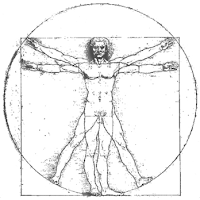Week 3: Robotics + Art
Since the dawn of
industrialization, what we perceive as art has changed dramatically, thanks
ultimately to mechanization. The
explosion of personal computers and Moore’s Law in the latter half of the 20th
century further drove mechanization and computation to set the stage for a new
type of masterpiece: robotics (Intel.com).
 |
| Vitruvian Man |
What was once
reserved for sculptures and paintings, humanoids became a new focus of
idealized beauty. During the
Renaissance, artists such as Leonardo da Vinci focused on this idealized,
perfect human form, as seen in his Vitruvian Man; but recently, humanoid
designers have taken up this focus on realistic human idealization (Stanford.edu). Dr. Dennis Hong, Professor of Mechanical and
Aerospace Engineering at UCLA, has succeeded in this blending of art and
science into CHARLI, “the United States’ first full-size autonomous human
robot” (Hong). CHARLI is able to walk in
any direction, as well as kick, and perform several upper body tasks. On top of all this, CHARLI is aesthetically
pleasing to look at, and includes this idea of human beauty within robotics.
 |
| CHARLI |
 |
| Iron Man |
Another great
example of this idea of blending an aesthetically pleasing robot in an
idealized human form can be seen in the Iron Man movie series. The Iron Man suit contains hundreds of “bells
and whistles”, but does all of this in the form of a very large and muscular
idealized human body.
While the
increased mechanization and computing capabilities have made this new art form
of robotics possible, some have argued that it has ultimately taken the
originality out of art. Walter Benjamin,
in his “The Work of Art in the Age of Mechanical Reproduction”, argues that mechanization
has allowed for art to be reproduced so closely to its original form that there
is no distinction between the real and reproduced; besides the fact that the
original work includes the aura of the culture and time. This mechanical reproduction ultimately
destroys the authenticity of the art as the “unique existence” of the original
work becomes lost (Benjamin). Douglas
Davis continues upon Benjamin’s work, further expanding on the idea that
mechanization and computing has devalued, rather than enhanced, art (Davis).
References:
“50 Years of Moore's
Law.” Intel, 2015, www.intel.com/content/www/us/en/silicon-innovations/moores-law-technology.html.
Accessed 21 Apr. 2017.
Benjamin,
Walter. “The Work of Art in the
Age of Mechanical Reproduction”. 1936.
Davis, Douglas. “The
Work of Art in the Age of Digital Reproduction (An Evolving Thesis: 1991-1995).” Leonardo,
vol. 28, no. 5, 1995, pp. 381-386.
Hong, Dennis.
“CHARLI: Cognitive Humanoid Autonomous Robot with Learning Intelligence.” RoMeLa,
UCLA, 2017, www.romela.org/charli-cognitive-humanoid-autonomous-robot-with-learning-intelligence/.
Accessed 21 Apr. 2017.
“Leonardo's Vitruvian
Man.” Stanford History, 2017,
leonardodavinci.stanford.edu/submissions/clabaugh/history/leonardo.html.
Accessed 21 Apr. 2017.



Comments
Post a Comment